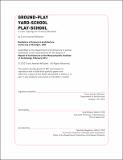| dc.contributor.advisor | Ana Miljacki. | en_US |
| dc.contributor.author | Williams, Travis Andrew | en_US |
| dc.contributor.other | Massachusetts Institute of Technology. Department of Architecture. | en_US |
| dc.date.accessioned | 2013-06-17T19:01:52Z | |
| dc.date.available | 2013-06-17T19:01:52Z | |
| dc.date.copyright | 2013 | en_US |
| dc.date.issued | 2013 | en_US |
| dc.identifier.uri | http://hdl.handle.net/1721.1/79140 | |
| dc.description | Thesis (M. Arch.)--Massachusetts Institute of Technology, Dept. of Architecture, 2013. | en_US |
| dc.description | This electronic version was submitted by the student author. The certified thesis is available in the Institute Archives and Special Collections. | en_US |
| dc.description | Cataloged from student-submitted PDF version of thesis. | en_US |
| dc.description | Includes bibliographical references (p. 218-221). | en_US |
| dc.description.abstract | This thesis explores how free play can be promoted, incentivized, and enabled through architecture to reinterpret the elementary school typology within the urban context of the Los Angeles Unified School District. The project is not a playground, but it is not just a school either. It functions as a play of ground that uses manipulated terrain to serve the programmatic needs of a school while also allowing for playful reinterpretation during its use. It combines the school yard with the school through the wielding of a visual datum of 56 inches that allows the space to be inhabited differently by adult faculty compared to young students. The system of ground is designed to be dextrous enough to create scalar variations in space and complex relationships between interior and exterior. It also exists as a recognizable language of objects, pauses, slopes and cliffs. These construct schools within schools, and rooms inside of other rooms serving students individually and collectively within a continuous volume where walls do not exist. In the end, the school tries to re-present a programmatically recognizable example of a typical school for the LAUSD. However, it does this while also creating a combination of play and school that is greater than the sum of those two parts and allows for scales of socialization that promote endless iterations of play. | en_US |
| dc.description.statementofresponsibility | by Travis Andrew Williams. | en_US |
| dc.format.extent | 221 p. | en_US |
| dc.language.iso | eng | en_US |
| dc.publisher | Massachusetts Institute of Technology | en_US |
| dc.rights | M.I.T. theses are protected by
copyright. They may be viewed from this source for any purpose, but
reproduction or distribution in any format is prohibited without written
permission. See provided URL for inquiries about permission. | en_US |
| dc.rights.uri | http://dspace.mit.edu/handle/1721.1/7582 | en_US |
| dc.subject | Architecture. | en_US |
| dc.title | Ground-play yard-school play-school : a Ludic typology for primary education | en_US |
| dc.title.alternative | Ludic typology for primary education | en_US |
| dc.type | Thesis | en_US |
| dc.description.degree | M.Arch. | en_US |
| dc.contributor.department | Massachusetts Institute of Technology. Department of Architecture | |
| dc.identifier.oclc | 844346607 | en_US |
